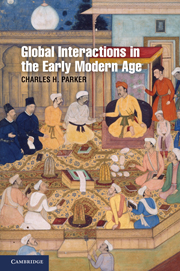Book contents
- Frontmatter
- Contents
- Maps
- Acknowledgments
- Global Interactions in the Early Modern Age, 1400–1800
- Introduction: The Global Integration of Space
- 1 European States and Overseas Empires
- 2 Asian States and Territorial Empires
- 3 International Markets and Global Exchange Networks
- 4 The Movement of Peoples and Diffusion of Cultures
- 5 The Formation of New Demographic and Ecological Structures
- 6 The Transmission of Religion and Culture
- Conclusion: Converging Destinies
- Notes
- Index
- References
6 - The Transmission of Religion and Culture
Published online by Cambridge University Press: 05 June 2012
- Frontmatter
- Contents
- Maps
- Acknowledgments
- Global Interactions in the Early Modern Age, 1400–1800
- Introduction: The Global Integration of Space
- 1 European States and Overseas Empires
- 2 Asian States and Territorial Empires
- 3 International Markets and Global Exchange Networks
- 4 The Movement of Peoples and Diffusion of Cultures
- 5 The Formation of New Demographic and Ecological Structures
- 6 The Transmission of Religion and Culture
- Conclusion: Converging Destinies
- Notes
- Index
- References
Summary
In September 1579, Akbar, the great Mughal emperor, requested that two Jesuit missionaries from the Portuguese station in Goa come to his capital in Fatehpur Sikri (northern India) to explain to him and his court the mysteries of the Christian religion. Professing an ecumenical belief known simply as the “Divine Faith,” Akbar promoted religious toleration and enjoyed theological debate, a rarity in the early modern world. The Jesuits dispatched three (instead of two) of their most learned priests, Rudolph Acquaviva, Francis Henriques, and Anthony Monserrate. They resided at the Mughal court for almost three years, during which time they participated in many religious conversations with Akbar and held theological disputations with Muslims and Hindus. In and around the Mughal court, the Christian missionaries, Muslim mullahs, Hindu gurus, and others debated issues such as whether Jesus was the Son of God, whether Muhammad was God's greatest prophet, and whether Krishna was a divine incarnation.
In one exchange, Akbar observed that the Qu'ran claimed that Jesus foretold Muhammad's arrival when Christ promised a “Holy Spirit which the Father shall send in my name [to] teach you all things.” To this way of thinking, Muhammad was a holy figure who came to fulfill Christ's mission. But the Jesuit Monserrate answered sharply that “Christ made no definite mention of Muhammad by name in the Gospel, but that he [Christ] spoke in general terms of many false prophets who were to come.” According to this line of interpretation, Muhammad was a false prophet and imposter.
- Type
- Chapter
- Information
- Global Interactions in the Early Modern Age, 1400–1800 , pp. 182 - 221Publisher: Cambridge University PressPrint publication year: 2010



